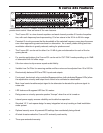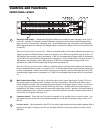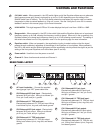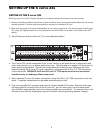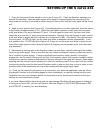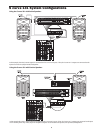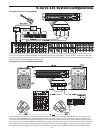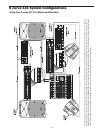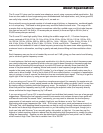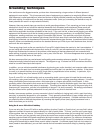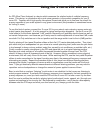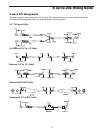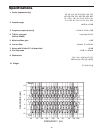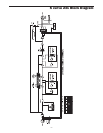
13
Using the S curve 231 with an RTA
An RTA (Real Time Analyzer) is a device which measures the relative levels of multiple frequency
areas. This device, in conjunction with a pink noise generator, is the perfect companion for your S
curve 231. Together with a high quality microphone, these tools allow you to fine tune the overall fre-
quency response of your audio system in any given environment (this procedure is sometimes known
as “tuning” a room).
To use this kind of system, connect the S curve 231 to your mixer’s main outputs or across main mix
output inserts (see pages 8 - 9 in this manual for typical configuration diagrams). Set the S curve 231
Level slider(s) to the center detented “0 dB” position. Because you’ll probably need to boost as well as
cut certain frequencies—and because you’ll rarely need to make adjustments of more than 6 dB, make
sure both Cut Only switches are in the out position and the range switch is set to the in (6dB) position.
Start by placing all front panel Equalizer sliders at their flat (“0”) center detented position. Then inject
pink noise into your loudspeakers via your mixer at a normal operating level (make sure the pink noise
is loud enough to drown out any ambient noise floor caused by air conditioners or outside traffic, etc.).
Finally, connect a quality microphone to the RTA and place the mic in a typical listening position.
Because pink noise consists of all audible frequencies blended together at equal level, the RTA
should, in theory, show all frequency bands to be flat. However, due to anomalies in every physical
environment, this will rarely if ever be the case. While watching the RTA, use the front panel Equalizer
sliders to make corrections to the signal, boosting any dips in the measured frequency response and
attenuating any peaks. Repeat the procedure three or four times from different listening positions,
averaging the results if necessary to come up with an equalization curve that works well at all posi-
tions. If you get drastically different measurements at different listening positions, you may need to
reposition various loudspeakers or change the amount of power applied to some of them.
Bear in mind that an analyzer “listening” to pink noise is no substitute for the human ear listening to
actual program material. A perfectly flat frequency response is not necessarily the best sounding fre-
quency response, so, once you have used the RTA and the S curve 231 to tune a room “by the num-
bers” be sure to audition the results by playing typical audio signal (music, speech, etc.) through your
system and continue to fine tune by ear. Be prepared to compromise—and if there’s a discrepancy
between what the RTA says and what your own ears tell you, always go with the latter.



